stepping out

¿Adonde vas?
Machu Picchu.
¿Dedonde?
Voy caminando desde Cusco.
¿Caminando?
Sí...
¡Estas loco, gringuito!

From Cusco I wanted to reach Machu Picchu - some 60 miles away - on foot. Lots of people do it by hiking the famously beaufiful 'Inca Trail,' but they make reservations a year in advance. Yeeeah right. There were other walking options through the mountains, but it appeared I would need a guide. My last two guided hikes in Bolivia were spectacular - and safe - but I've learned that the pace is determined less by the scenery and the people you meet along the way than by your guide's back-to-back trip schedule. I wanted to go alone, on my own time.
After a frustrating afternoon trying to get information from the you-will-definitely-need-a-guide tour agencies surrounding Cusco's main plaza, I went for a pizza. A testament to the level of tourism in the area, there are more wood-oven pizza huecos (holes in the wall) per-capita in central Cusco than anywhere else in the world. After a week 'keepin it real' on market food, the cracker crust and creamy aiolí slathered atop bubbling cheese nearly brought me to tears. Halfway through my pie the couple at the next table finished their meal, and left behind the paper they had been studying over dinner - a hand drawn sketch of Cusco and the surrounding countryside.
The map showed a straightforward route to MachuPicchu. Climb the hills east of Cusco and traverse a few miles of foothills to the Valle Sagrado (Sacred Valley). Once in the Valley I could follow the meandering path of the Urubamba River all the way to the base of the ruins.

Alone in potato fields an hour from my front door.

Before leaving I bought a compass. The thing never left my pack. Whatever the colored-pencil sketch lacked in geographic accuracy, it made up for with the names of towns and landmarks that it identified along the way. A map made for asking directions.
 Karín and her mother guided me and their three mules on an inconspicuous path along the falda (skirt) of the hills to the saddle where the trail descends into the Valley.
Karín and her mother guided me and their three mules on an inconspicuous path along the falda (skirt) of the hills to the saddle where the trail descends into the Valley.I had a late afternoon snack with a family harvesting potatoes. Coffee and watia (Quechua for dirt-clod potatoes)

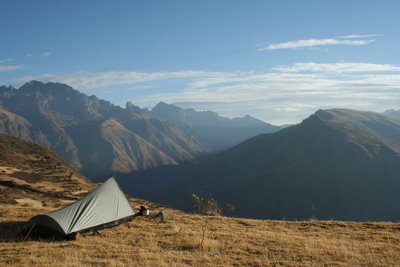
Though I estimated the trip would last five or six days, I packed enough butter, flour, and powdered soup to last for two weeks. Why didn't it occur to me that I might  not need that much food on a hike through one of the most fertile areas in Peru? The prodigious agricultural capacity of el Valle supported Inca imperial expansion, stretching from modern Ecuador to southern Chile at its zenith, and made possible the incredible settlements they built in the Valley. In 'anapia papas' I incorrectly implied that the potato was the most important staple of Andean civilization. Modern scholars agree that the potato alone could not have sustained the major population centers of Inca and pre-Inca civilization. To this day, the primary crop in the SacredValley is still a special variety of high-altitude maize. With kernels the size of nickels, the famous choclo del Valle is supposedly the tastiest corn on the cob in the world. If only I could stick around another six months till the harvest to try some.
not need that much food on a hike through one of the most fertile areas in Peru? The prodigious agricultural capacity of el Valle supported Inca imperial expansion, stretching from modern Ecuador to southern Chile at its zenith, and made possible the incredible settlements they built in the Valley. In 'anapia papas' I incorrectly implied that the potato was the most important staple of Andean civilization. Modern scholars agree that the potato alone could not have sustained the major population centers of Inca and pre-Inca civilization. To this day, the primary crop in the SacredValley is still a special variety of high-altitude maize. With kernels the size of nickels, the famous choclo del Valle is supposedly the tastiest corn on the cob in the world. If only I could stick around another six months till the harvest to try some.
 This time of year the best way to sample the corn is in liquid form, lightly fermented in earthenware drums and served at room temperature in tall glasses for ten cents a liter. Oh yes, I'm talking again about chicha, affectionately known here as 'champagne of the Valley.' The first sip is not as immediately pleasant as the sweet grape chicha I wrote about in 'colchagua chicha', but the bitter tang of chicha de maiz makes a whole glass (or two) infinitely more refreshing. Every chance I got I rested my blistery feet at a chicheria. Once you figure out what the red plastic bag hanging from a pole at the doorway means, homemade chicha is easy to find. Chickens peck at your feet while tinny Andean pop music - no resemblance to the traditional flute-based folk music - drones on cranky old speakers.
This time of year the best way to sample the corn is in liquid form, lightly fermented in earthenware drums and served at room temperature in tall glasses for ten cents a liter. Oh yes, I'm talking again about chicha, affectionately known here as 'champagne of the Valley.' The first sip is not as immediately pleasant as the sweet grape chicha I wrote about in 'colchagua chicha', but the bitter tang of chicha de maiz makes a whole glass (or two) infinitely more refreshing. Every chance I got I rested my blistery feet at a chicheria. Once you figure out what the red plastic bag hanging from a pole at the doorway means, homemade chicha is easy to find. Chickens peck at your feet while tinny Andean pop music - no resemblance to the traditional flute-based folk music - drones on cranky old speakers. Unless you've got the guts of a campesino, it's advisable not to drink  chicha too close to bedtime as it continues to ferment for a while in your stomach. Frutillada - chicha dyed pink with fresh strawberry puree and airampo, a seed with antiseptic properties that stops the fermentation - is a lucky afternoon treat.
chicha too close to bedtime as it continues to ferment for a while in your stomach. Frutillada - chicha dyed pink with fresh strawberry puree and airampo, a seed with antiseptic properties that stops the fermentation - is a lucky afternoon treat.
Chicha isn't just for drinking. I rested one night at a hostel that had a wood burning oven, and made pizza dough leavened with chicha. The señora of the house said the crust tasted like the bread of her childhood, before bakers 'got lazy' and started using packaged yeast. Another day I got to try adobo - pork shoulder braised in chicha, vegetables, and aromatics. Dios mio.
An old farmer noticed me limping past his house and invited me in for corn and beans. Two dozen fattened cuy (guinea pigs) squealed and scattered when we entered the kitchen. Birthday food, he said. His grandchildren arrived a bit later and I made everyone coffee (ahh, another half hour!) The boys offered to show me the salt terraces in the hills nearby.
Aww, don't want to carry your pack today? How about a hundred pound sack of salt? Salty spring water is diverted into thousands of pools - each one owned and worked by the same family for generations - and left to dry in the sun. Once crystalized it is bagged, sold to a distributor ($1.50 for 50 kilos), and hauled to a storage shack.
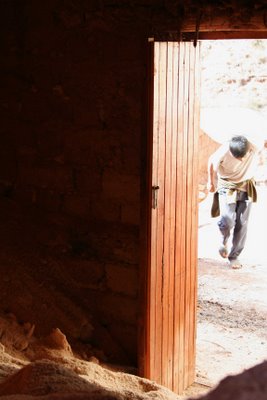
Luis, David, and José couldn't get enough of the frame-by-frame shots of themselves doing 'cartwheels.'  They'd eat it, come running to see the pictures, laugh hysterically, and do it all over again. On the way back home they told me about the hidden lakes and streams in the mountains to the east - a half day's scramble up a steep ravine - that are teeming with big, dumb trout. They took a trip there the year before, carrying only fishing tackle, a frying pan, a bag of flour mixed with salt and spices, and two quarts of oil. For three days straight they slept in caves and ate wild potatoes and fried trout. When are you guys going to take me? 'Cuando regresas,' they replied, as if to make sure I would return.
They'd eat it, come running to see the pictures, laugh hysterically, and do it all over again. On the way back home they told me about the hidden lakes and streams in the mountains to the east - a half day's scramble up a steep ravine - that are teeming with big, dumb trout. They took a trip there the year before, carrying only fishing tackle, a frying pan, a bag of flour mixed with salt and spices, and two quarts of oil. For three days straight they slept in caves and ate wild potatoes and fried trout. When are you guys going to take me? 'Cuando regresas,' they replied, as if to make sure I would return.
 After hanging out all day, cooking dinner, and helping me pitch the tent, they wanted to camp too. It was clear my three new friends would not take 'no' for an answer, so we slept four in my one-person tent.
After hanging out all day, cooking dinner, and helping me pitch the tent, they wanted to camp too. It was clear my three new friends would not take 'no' for an answer, so we slept four in my one-person tent.
'Pankaes' for breakfast the next morning.
La Familia Peralta
I was hoping to find someone to roast me my first cuy on the 15th. No such luck. But I did spend most of the afternoon on an uninhabited stretch of highway gorging myself on fat ripe tunas (cactus fruit)... and most of the evening tweezing the deceptively fuzzy spines from the webbing of my fingers.
An hour before sunset, I reached the town 'Km82.' The official Inca Trail starts on the other side of the river, and there are a dozen officers working around the clock to make sure nobody without a permit crosses to get to the trail. Luckily you don't have to cross to follow the more direct route along the river to MachuPicchu. Unfortunately PeruRail, the foreign-owned railroad monopoly that controls the passage from Cusco along the same river, also pays the guards extra to make sure no tourists avoid the $55 tariff (each way) by hiking along the tracks.
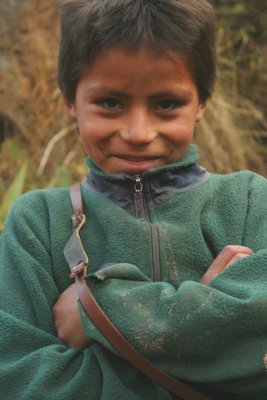 I met Darwin hanging out on a rock after an afternoon hunting birds with a slingshot. He knew a good trail around the guards. I offered to pay him a little more to take me to a good campsite. He had to be home before dark, but assured me I would find a good place to camp at some ruins a litttle further down.
I met Darwin hanging out on a rock after an afternoon hunting birds with a slingshot. He knew a good trail around the guards. I offered to pay him a little more to take me to a good campsite. He had to be home before dark, but assured me I would find a good place to camp at some ruins a litttle further down.
The valley narrows until it becomes a steep gorge and the gentle Urubamba becomes a series of thundering cataracts that I often mistook for an oncoming train. As you descend the vegetation changes radically, and just a day after eating cactus fruit I was hunting guavas in the dense foliage that lined the tracks.
The next morning I was up at 4am, performing my morning ritual: fried eggs, coffee, and blister repair. I reached main terrace as the sun shot its first light over the craggy horizon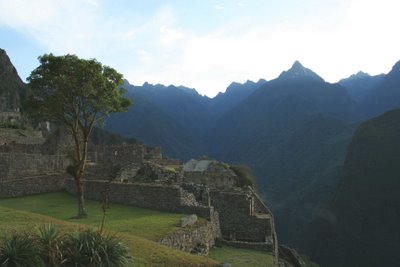 .
.
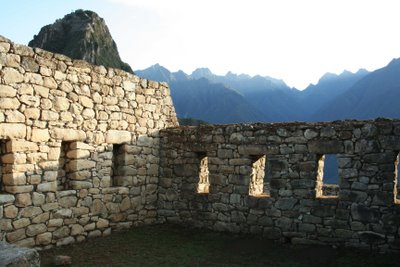 Eight days after setting out I was on the train back to Cusco. The trip would have lasted a month had I returned on foot to take up the invitations to 'go fishing' and roast a pollo
Eight days after setting out I was on the train back to Cusco. The trip would have lasted a month had I returned on foot to take up the invitations to 'go fishing' and roast a pollo
or a cuy on my return. I'll walk both ways next time. With better shoes. And less food.




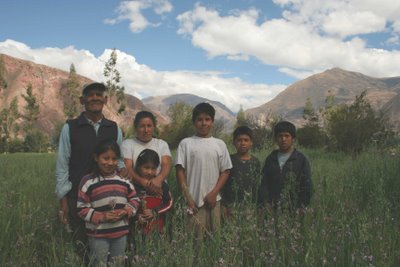




18 Comments:
Amazing photos and writing. I can't wait to see you and hear all about your trip when you get back. Take care!
Eric, this entry is the best. I loved it. Miss you oodles.
Mercedes
I HATE YOU!!!!!!!!!!!!!
you've captured culture at it's purest form. thank you for the journey...
i'm looking forward to hearing your stories in person:)
i wish you well
mary
I am soooooo glad you purchased that camera! You are quite the photojournalist- something about the essence of those boys you captured. They have genuine freedom in their eyes....It seems as though you couldnt be better. I would never come back if i were you. Good luck on the path that lies ahead!
Ciao ciao,
Lynnie
Eric, I so wish I could be there right now, stunningly beautiful.
italian food always on your mind...had to read a lot, i was a bit far behind.. each entry is better than the one before. love, claudia
Buena Vibra!!!!
Hi Eric,
I am a friend of the Galland's and Hilary alerted me to your blog, great photos.
I live in Quito and work in agriculture. I was wondering if you were passing through Ecuador. I am working on one project in particular that has to do with cooking native foods that I wanted to discuss with you.
Saludos,
Claire Nicklin
clairenicklin@gmail.com
It's great to hear about your journey my brother! I look forward to seeing you in SF soon.
Eric,
your pictures are beautiful,what an amaising journey!I can't wait to hear about your travels. Hope to see you soon in S.D. Surfs been fun lately,and the waters still warm.I hope your doing well!TAke care-
Jennifer
Eric, wonderful pics. Got your blog address at a conference froms someone called Cynthia. Keep writing!
Hans
Hi, I don't think you've ever met me officially (although I think you did once come to my English class), but I'm Liz, an '02 graduate of LJHS (and LJXC) who was sent to your blog by Coach Dorman to read of your and his experiences with dirt clod oven potato preparation. As a writer and sometimes-blogger myself who always appreciates the knowledge that my words have been read and appreciated, I wanted to express my enjoyment of your postings. They are beautiful and engaging and inspiring, and I look forward to more tales of your wandering journey. Thanks, and happy travels!
Hola Eric, soy Jade recuerdas que nos conocimos en el vuelo de lan y me diste tu pagina, y ahora que ya lo vi solo me queda felicitarte por las maravillosas fotos que tomaste, espero estemos en contacto mi mail es jadegw19@hotmail.com un super abrazo bye
Eric, I just ate the delicious bun you baked and was looking at the pictures from your trip...quite an amazing undertaking!!! The quote at the beginning is very applicable:)
I enjoyed reading your story, keep them coming.
Lina
I am so happy for you (and so jealous). I love reading this! Hopefully I'll get to see you soon... but I'm in Boston...
Take care, keep having fun,
love,
Michaela
Wow Eric! You had an amazing trip in Peru. You're definitely braver and tougher than I am. I cannot believe I felt like dying during my 5-day Inca trail. You did it the real backpacker way. I'm glad my country was generous to you. I did not only liked your pictures, but the writing brought the whole experience to life. PS You forgot your white board at Delfina last night.
Liz
Borgata Hotel Casino & Spa - MapYRO
A map 전라북도 출장샵 showing 충청남도 출장안마 Borgata Hotel Casino & Spa 태백 출장마사지 - See 1266 traveler reviews, 878 김천 출장샵 candid photos, and great 인천광역 출장안마 deals for Borgata Hotel Casino & Spa in Atlantic City, NJ at MapYRO.
Post a Comment
<< Home